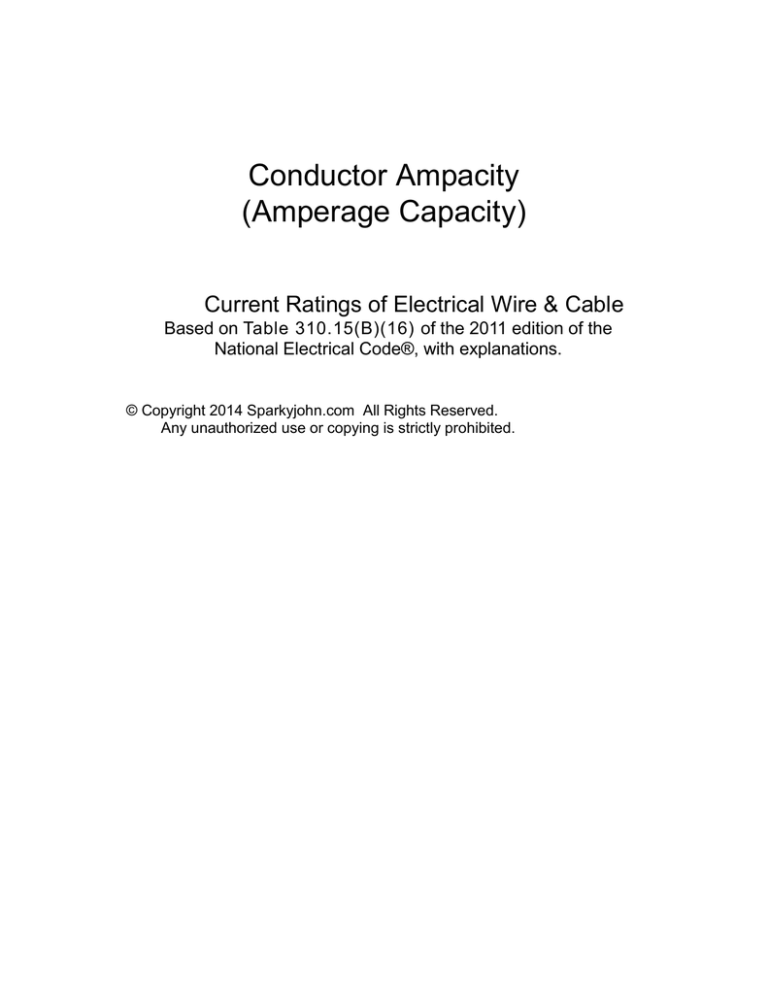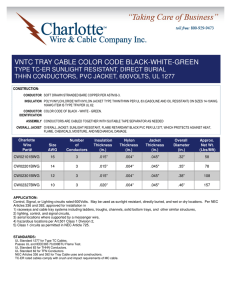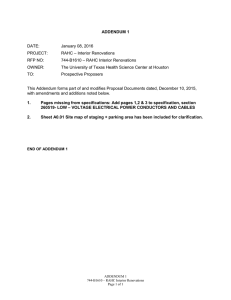
Conductor Ampacity
(Amperage Capacity)
Current Ratings of Electrical Wire & Cable
Based on Table 310.15(B)(16) of the 2011 edition of the
National Electrical Code®, with explanations.
© Copyright 2014 Sparkyjohn.com All Rights Reserved.
Any unauthorized use or copying is strictly prohibited.
When you look at Table 310.15(B)(16) in the N.E.C. (National Electrical Code),
The ratings I have shown in my table, do NOT correspond with what you will find
in the aforementioned Table. For Example, THHN conductors are shown in the
90°C column. This is the starting point for calculating the current carrying
capabilities of a THHN conductor. You have to reduce its ampacity based on the
temperature of its environment, & based on how many conductors are in the
raceway. In the process of conducting current, heat is generated. The conductors
in a pipe or raceway give off heat, and the greater the number of conductors, the
more difficult it is for them to dissipate heat. For example: Conductors in a
conduit in the basement of a single family dwelling, probably would have no
difficulty dissipating any heat generated. Conductors in a conduit, or a roof in the
blazing heat of a summer sun on the hottest day of the year, would find it hard to
dissipate heat, and you have to limit the load imposed upon them. Similarly,
running raceways through lower temperature areas increase their current
carrying capabilities. The process of applying correction factors is called “Derating”.
Although Type NM-B cable (Romex ®) contains 90°C conductors, Article
334.80 limits its Ampacity to the 60°C level. I have this shown in the chart below.
UF (Underground Feeder) cable is also shown in the 60°C column.
Type THHN insulated conductors are shown in the chart in the 90°C
column, but cannot be used at that level, and they are to be protected based on
their 75°C rating. The terminal ratings of devices (Switches, outlets, circuit
breakers, etc) are usually limited to 75°C, and may be damaged if subjected to
the higher temperatures. TW is an older insulation type.
A brief explanation of the more common insulation types:
TW
Thermoplastic, Water resistant
THW
Thermoplastic, Heat resistant, Water resistant
THHN
Thermoplastic, High Heat resistant, Nylon Jacketed
THWN
Thermoplastic, Heat resistant, Water resistant Nylon Jacketed
RHW
Rubber jacketed, Heat resistant, Water resistant
Table 310.15(B)(16) in the N.E.C. gives higher ampacities than shown in the
table that follows. The higher ratings are the starting point for de-rating factors.
This is especially true for 14,12, & 10 A.W.G. (American Wire Gage) sizes.
Article 240.4(D)(3), (5) & (7) limits those sizes to the values shown in the table
that follows.
Allowable Ampacities of Insulated Conductors Rated 0 Through 2000 Volts, 60°C
Through 90°C, Not More Than Three Current-Carrying Conductors in Raceway,
Cable, or Earth, Based on Ambient Temperature of 30°C (86°F)
These are the MAXIMUM ratings allowed, and you may have to reduce them
further based upon the number of conductors in the raceway, and the ambient
temperature. This table is for the convenience of the casual user, and if you are
uncertain as to your situation, consult a local professional.
Wire
Size
14
12
10
8
6
4
3
2
1
1/0
2/0
3/0
4/0
Temperature Rating of
COPPER Conductors
60°C (140°F) 75°C (167°F)
NM Cable
THHN
(Romex®)
THW, THHW
UF Cable
THWN, RHW
TW
XHHW, USE
15
15
20
20
30
30
40
50
55
65
70
85
85
100
95
115
110
130
125
150
145
175
165
200
195
230
© Copyright 2014 Sparkyjohn.com All Rights Reserved.
Any unauthorized use or copying is strictly prohibited.





